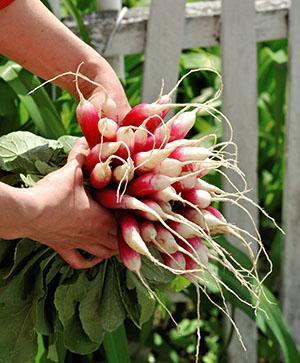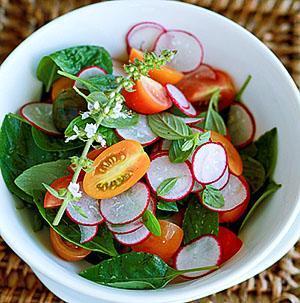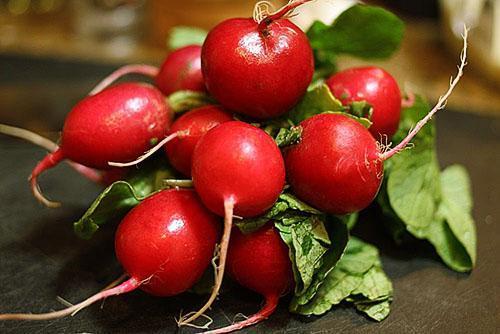Useful properties of radishes
 In the spring and early summer, when the rest of the garden crops have just been planted in the beds and are gaining strength, the juicy crunchy radish roots are ready to eat. But the value of an early vegetable is not only in its early maturity and sweetish, with a slight pungency in taste, but also in the beneficial properties of radishes.
In the spring and early summer, when the rest of the garden crops have just been planted in the beds and are gaining strength, the juicy crunchy radish roots are ready to eat. But the value of an early vegetable is not only in its early maturity and sweetish, with a slight pungency in taste, but also in the beneficial properties of radishes.
If more recently with beds Since the root crops were mainly of a red-pink hue, today gardeners are offered varieties that give radishes of white, pale pink, yellow and purple colors. On the table of lovers of early vegetables, not only rounded, but also oblong root vegetables, up to 10-15 cm long, fall.
What are the benefits of radish? What is the composition of this vegetable, and are root crops of different colors equally useful?
Composition and calorie content of radish

The list of mineral elements in the composition of radish is no less extensive. This is calcium necessary for the formation of bones, iron, which is indispensable in the process of hematopoiesis, which ensures the functioning of the nervous and cardiovascular systems, magnesium and potassium. The roots and tops of radish also contain phosphorus, zinc and sodium, copper and iodine, which are involved in the work of the endocrine system. What else is radish useful for?
In addition, there are many phytoncides in the crispy pulp and young foliage that have a natural antimicrobial, antiseptic effect. Mustard oil has a similar property, which determines the taste of the vegetable and its characteristic pungency.
 Even the pinkish-red color of the root vegetable matters when it comes to the health benefits of radishes.
Even the pinkish-red color of the root vegetable matters when it comes to the health benefits of radishes.
The richer the color, the more anthocyanins in the surface layer, which have pronounced antioxidant properties.
It is important that the calorie content of radishes is very low. Depending on the variety and growing conditions, there are only 16–21 kcal per 100 grams of root crops and tops. At the same time, 94.8% of radish consists of moisture, 2.4% of the weight is carbohydrates, and another 1.5% is fiber.
Useful properties of radish
 The content of active substances in all edible parts of the plant determines the benefits of radishes.and in relation to human health. First of all, it is worth noting that with the pleasure of eating early roots, many forget about such a source of vitamins, trace elements, tannins and organic substances, like radish tops.
The content of active substances in all edible parts of the plant determines the benefits of radishes.and in relation to human health. First of all, it is worth noting that with the pleasure of eating early roots, many forget about such a source of vitamins, trace elements, tannins and organic substances, like radish tops.
Young greens included in salads and cold snacks will provide the body with not only these vitamins and minerals, but also fiber.
Dietary fiber in the intestines acts as a brush, sweeping out toxins, stimulating the digestive system and increasing metabolism. Such a useful property of radish cannot be ignored in the prevention and treatment of atherosclerosis, since an excess amount of cholesterol leaves the body with fiber.
Eating fiber-rich foliage and root vegetables is good for:
- with weakened intestinal peristalsis;
- if you want to reduce weight and cleanse the body of toxins;
- to activate digestive processes and metabolism;
- if you have problems with the bowel movement.
 The benefits of radish and the effect of its use are complemented by organic acids, phytoncides and essential oils, which have a warming, disinfecting and tonic effect. The vitamins that enter the body with the first salads made from radish and spring greens are also extremely important. This is an excellent remedy not only for vitamin deficiency, but also for the accompanying bad mood, decreased vitality and stress.
The benefits of radish and the effect of its use are complemented by organic acids, phytoncides and essential oils, which have a warming, disinfecting and tonic effect. The vitamins that enter the body with the first salads made from radish and spring greens are also extremely important. This is an excellent remedy not only for vitamin deficiency, but also for the accompanying bad mood, decreased vitality and stress.
Anthocyanins, which are responsible for the rich color of the surface of root crops, as well as actively prevent the development of tumor formations, and have a beneficial effect on blood vessels and tissues, also contribute to the bouquet of useful properties of radish.
 If you want to use the vegetable as a natural anticancer drug, it is better to give preference to red or purple root vegetables, they have a higher content of anthocyanins, which means that the beneficial properties of radish are more noticeable. In the spring, when immunity is reduced, phytoncides in the composition radish will become a natural defense against colds, infections and inflammation. And such a benefit of radish is difficult to overestimate!
If you want to use the vegetable as a natural anticancer drug, it is better to give preference to red or purple root vegetables, they have a higher content of anthocyanins, which means that the beneficial properties of radish are more noticeable. In the spring, when immunity is reduced, phytoncides in the composition radish will become a natural defense against colds, infections and inflammation. And such a benefit of radish is difficult to overestimate!
Moreover, the disinfecting effect of the plant can be felt with the external use of gruel from crushed leaves and root crops. Traditional medicine recommends using this remedy as compresses for painful sensations in the joints, after bruises and other medium-sized injuries.
The juice and pulp of radish are useful in the form of an improvised means for disinfection and mild anesthesia for abrasions and diseases accompanied by damage to the skin.
Due to the local irritating effect, such a lotion:
- distract from painful sensations;
- relieve inflammation;
- will stop the development of a bacterial infection.
The low calorie content of radishes, combined with the presence of natural sugars and fiber, attract the attention of nutritionists to the vegetable.
How is radish useful in this case? A salad with crispy root vegetables will create a feeling of satiety, replenish energy reserves, but will not leave a single extra centimeter at the waist.
 At the same time, everyone who cares about their appearance should not be limited to salads and radish snacks. This vegetable will help:
At the same time, everyone who cares about their appearance should not be limited to salads and radish snacks. This vegetable will help:
- moisturize the skin of the face and neck;
- relieve acne inflammation;
- relieve itching and disinfect the skin under the hair with seborrhea.
Masks and rubbing with radish pulp or juice will improve the complexion, increase its tone and remove excess sebum.
Contraindications for the use of radish
 But with a lot of useful properties, radish in some cases can also cause a deterioration in health. Moreover, the same compounds are capable of provoking an exacerbation of a particular disease, which are beneficial when using root crops and young tops.
But with a lot of useful properties, radish in some cases can also cause a deterioration in health. Moreover, the same compounds are capable of provoking an exacerbation of a particular disease, which are beneficial when using root crops and young tops.
First of all, the high content of irritating substances should be taken into account by people suffering from gastritis, peptic ulcer and other diseases of the gastrointestinal tract. If a person has severe intestinal motility problems, eating radishes can cause painful cramps and make the situation worse.
Oxalic acid in greens and root vegetables is not always safe for kidney patients.
In excessive quantities, radishes are not at all useful for people who are at risk of strokes and heart attacks, as well as with a predisposition to varicose veins.
 There is also an individual intolerance to the vegetable, expressed in local allergic reactions and a general deterioration in well-being. Most often, the reason for this is the essential mustard oil, as well as natural pigments that give the root crop such a bright appearance.
There is also an individual intolerance to the vegetable, expressed in local allergic reactions and a general deterioration in well-being. Most often, the reason for this is the essential mustard oil, as well as natural pigments that give the root crop such a bright appearance.
In order not to be afraid for your health and still consume radishes in small quantities, it is better to pay attention to the white varieties or remove the top painted layer before eating the root crop.
No matter how miraculous the effect of a vegetable on the body is, the real benefits of radish are possible only when used in combination with other food groups and taking into account the state of human health and the recommendations of medical specialists. In addition, only fresh juicy root vegetables grown in environmentally safe areas should be placed on the table.